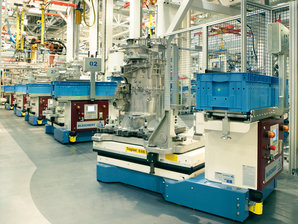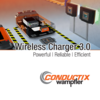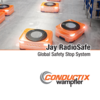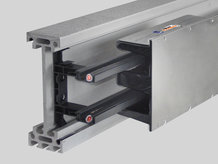Automated Guided Vehicles
In today’s production and material handling processes Automated Guided Vehicles (AGVs) are established as one of the most versatile solution for in-plant transports. Among all the unique advantages of this technology, there is one major challenge: the energy supply concept. For the key advantage of autonomous navigation on the factory floor – compared to track mounted systems – conventional power transmission technologies hold too many limitations.
A standard solution for this challenge is the use of on-board energy storages, like batteries or super-capacitors. These energy storages need frequent recharges. Charging can take place either on board of the AGV or outside the AGV with an energy storage swapping and charging station.
Thanks to striking technical and economical advantages contactless, inductive power transfer, often in conjunction with inductive data communication, guidance and positioning, is established as a state-of-the-art solution by now.
For floor surface conveyors, the goal is to achieve a level floor with no obstacles for persons, forklifts or other equipment in the factory environment, to eliminate hazardous contact rails, and to render batteries in vehicles either superfluous or more efficient.
To achieve this, the primary track is installed in the floor or other surface along the path of travel.
The IPT® Floorsystem can be placed continuously along the entire path of travel or only in defined areas. The advantage of continuous power transfer is the total elimination of energy storage devices on the vehicles. This cuts costs related to maintenance and replacement of batteries, and often fewer vehicles are required, since none are off-line for charging. Vehicles with their own on board power source are preferable when there are long paths that are infrequently travelled or if there are very complex or variable paths, which can make it unfeasible to put cables in the floor. Using inductive charging paths this way has the beneficial effect of permitting opportunity charging while travelling or at idle positions. iDAT is the optimum addition to continuous inductive power transfer. iDAT makes it possible to guide vehicles precisely along the magnetic field produced by the power transfer, to give them position information via position marks, and to transfer bidirectional data without interference between vehicles and the master controller.
Today IPT ® has established itself as a widespread alternative energy concept for Automated Guided Vehicles. It is predominant for AGVs integrated in the production processes such as assembly of gearboxes, engines or axles. Hybrid vehicles on the other hand, which use IPT® in conjunction with batteries or capacitors, are increasingly used for example in logistics processes. The possibility to downsize the energy storage as well as the peak power supply requirements and an increase in the overall system flexibility are the main driving factors for this development.
-
Handling of airplane structural part [ keel beam ] due to a automated guided vehicle
Reference Report
[REF9000-0018-E]
Verplaatsing van een vliegtuig onderdeel [ keel beam ] d.m.v. een automatisch gestuurd voertuig (AGV)
Toepassing
Verplaatsing van een vliegtuig onderdeel [keel beam] d.m.v. een automatisch gestuurd voertuig (AGV)
Land
Frankrijk
Plaats
Nantes
Verantwoordelijk verkoopkantoor
Conductix-Wampfler [F]
Operator
EADS / Airbus
Technische eisen
Elektrische voeding voor het automatisch gestuurde voertuig (AGV
Baanlengte
220 m
Aantal voertuigen
1
Aanvullende informatie [voertuig]
- Gewicht: 13 t
- Laadgewicht: 35 t
Product
- IPT® (Inductive Power Transfer)
- iDAT guidance
Voeding
- 9 kW voor rijden
- 5,5 kW voor liften
Speciale kenmerken
- Beweging van het voertuig in beide richtingen
- Rijprecisie +/- 2 mm bij rijden met ontwerpsnelheid
- Positioneringsprecisie +/- 1 mm bij de parkeerplaatsen voor het liften
- Geleiding en positionering wordt bestuurd door
3 iDAT pickups op beide assen
Relevant Products
Inductive Power Transfer
Additional information
Inductive Power Transfer creëert veel mogelijkheden voor ontwerpers die op zoek zijn naar mobiele voedingssystemen. Inductive Power Transfer is het eerste grootschalig contactloze power transfer systeem dat zich heeft gerevolutioneerd waardoor allerlei soorten bewegende machines kunnen worden voorzien van stroom.
Gebaseerd op het principe van elektrische inductie en het in acht nemen van de moderne industriële behoeften van klanten, heeft Conductix-Wampfler een systeem ontwikkeld wat een technologische doorbraak is op het gebied van elektrische voeding.
Downloads
Conductix-Wampfler B.V. [Netherlands]
Diamantlaan 87
2132 WV Hoofddorp
Netherlands
Phone: +31 (0) 23 542 12 00
www.conductix.nl
info.nl@conductix.com
Conductix-Wampfler B.V. [Belgium]
Belgium
Phone: +32 (0) 2 469 25 60
www.conductix.be
info.be@conductix.com
- 2 more clicks for privacy: By clicking here, the button becomes active and you can send your recommendation to Facebook. With the activation data will be transmitted to third parties.mit Facebook verbunden

- 2 more clicks for privacy: By clicking here, the button becomes active and you can send your recommendation to Twitter. With the activation data will be transmitted to third parties.nicht mit Twitter verbunden













![Energy supply for the Automated Guided Vehicle Handling of airplane structural part [keel beam] due to a automated guided vehicle](https://www.conductix.nl/sites/default/files/styles/teaser-image/public/REF9000-0018_web_pic_1_105_1594_1.jpg?itok=llD-ouaC)
![Energy supply for the Automated Guided Vehicle Handling of airplane structural part [keel beam] due to a automated guided vehicle](https://www.conductix.nl/sites/default/files/styles/teaser-image/public/REF9000-0018_web_pic_2_105_1595_1.jpg?itok=h7ufkJXf)
![Energy supply for the Automated Guided Vehicle Handling of airplane structural part [keel beam] due to a automated guided vehicle](https://www.conductix.nl/sites/default/files/styles/teaser-image/public/REF9000-0018_web_pic_3_105_1596_1.jpg?itok=qllG3zvV)


